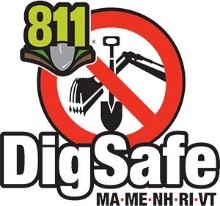
By Whitney Burgess, Poultney Mettowee Natural Resources Conservation District
If you are planning any tillage in the upcoming crop season, I am writing this for you! As utility infrastructure is continually expanding in underground networks, take a pause this winter and consider what impacts that they may have on your crop fields. I don’t mean to imply that the utilities may impact your crop yields for better or for worse, but rather that the presence of underground utilities may influence how you manage those fields. You may be aware of the unfortunate, accidental encounters of farmers and their equipment with underground utilities through the news. We don’t want our neighbors to find themselves in these unfortunate situations and want to pass along a few simple steps that can be taken for you to learn what lies beneath your field surfaces.
You may be familiar with “Dig Safe” but do you know that it is not just for digging in a conventional sense? In fact, Dig Safe is used broadly to keep those working in close proximity to underground utilities safe, and the utilities themselves intact. Dig Safe is FREE and accessible in two primary ways. One way to access Dig Safe’s services is to simply pick up your phone, dial 811, and speak with an operator. The other option is to navigate this process online, by going to Dig Safe’s website at www.DigSafe.com/exactix. Here you can register for an “Exactix” account to make a utility marking request, track and manage your fields or projects, and receive updates on the marking status. Having an “Exactix” account can be a great tool for tech savvy users.
Before contacting Dig Safe, prepare by marking field corners with flagging or stakes, and note the two closest roads that your field sits between. Dig Safe will request these road names to assure they have the correct location. From there, the utility company or a contractor of their hire will come out and mark your property if underground utilities are present using a color code indicative of the utility type (i.e. gas, water, electric, etc.). Be sure to plan ahead, and give Dig Safe at least 72 hours of notice before the date you plan to do your field work. For more information, visit www.DigSafe.com.
Now that you know what utilities lie beneath your field surfaces, you have an improved ability to plan and manage your crop fields while avoiding expensive and dangerous utility encounters. You may consider doing this when cropping on a new property or field, or simply when doing tillage on a field for the first time. That said, it never hurts to do a review even on a property you are familiar with. Erosion can cause utility depth to change over time and following a year of heavy rains this concern may resonate with many of you. Add this step to your field management this winter season and be more prepared for the next crop season. Stay safe out there!

